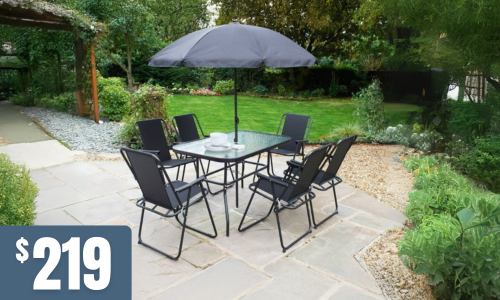Posts tagged with 'contemporary decor'
 In the realm of interior design, geometry serves as more than a mathematical concept; it emerges as a potent tool for creating visually arresting and organized living spaces. The prominence of geometric design in furniture has been steadily increasing, and its appeal is evident. With clean lines, precise angles, and harmonious patterns, geometric furniture effortlessly introduces structure and a modern aesthetic to your décor. In this article, we will delve into the allure of geometric design in furniture and explore how it can impart a sense of organisation to your living spaces.
In the realm of interior design, geometry serves as more than a mathematical concept; it emerges as a potent tool for creating visually arresting and organized living spaces. The prominence of geometric design in furniture has been steadily increasing, and its appeal is evident. With clean lines, precise angles, and harmonious patterns, geometric furniture effortlessly introduces structure and a modern aesthetic to your décor. In this article, we will delve into the allure of geometric design in furniture and explore how it can impart a sense of organisation to your living spaces.
Geometry in Furniture: A Time-Honoured Aesthetic:
The influence of geometry has pervaded furniture design for centuries, drawing inspiration from various architectural and design movements. From the iconic zigzags and chevrons of the Art Deco era to the clean lines of mid-century modernism, geometric patterns have etched their mark on the landscape of furniture design. Today, this design ethos is experiencing a revival, with geometric furniture taking centre stage in contemporary interior design.
Essential Elements of Geometric Furniture:
- Sleek Lines: Geometric furniture is characterised by its clean, straight lines. Whether it takes the form of a rectangular coffee table, a square bookshelf, or a triangular side table, these shapes contribute to the structured and orderly appearance of the furniture.
- Symmetry: Symmetrical patterns, such as repeated squares, circles, or hexagons, frequently feature prominently in geometric furniture. This symmetrical balance imbues the design with a sense of order and harmony.
- Contrast: Geometric furniture often relies on the interplay of contrasting elements, which may involve contrasting colours, materials, or shapes. These contrasts introduce visual interest and elevate geometric furniture pieces.
- Modularity: Many geometric furniture pieces are designed with modularity in mind. This means that you can rearrange or combine them to adapt to changing needs, enhancing the versatility of your décor.
Versatility of Geometric Furniture:
One of the most appealing aspects of geometric furniture is its versatility. It can seamlessly complement a wide range of interior design styles, from minimalistic and contemporary to industrial and retro. Here are some examples of how geometric furniture can enhance various living spaces:
- Living Room: Geometric coffee tables and shelving units can serve as captivating focal points, providing structure and functionality to your living area while offering a platform for showcasing your cherished décor items.
- Bedroom: A geometric bed frame or headboard can make a bold design statement, while geometric nightstands and dressers deliver storage solutions with a modern edge.
- Dining Area: Geometric dining tables and chairs can create an elegant, well-organised dining space, ideal for hosting guests.
- Home Office: Geometric desks and storage units not only offer a stylish workspace but also assist in maintaining an organised and clutter-free home office environment.
Pairing Geometric Furniture with Other Styles:
Geometric furniture can be seamlessly integrated with other design styles. For example, it can introduce structure and order to bohemian décor, introduce contrast in rustic settings, or enhance the sleekness of a contemporary space. Experiment with diverse combinations to strike the perfect balance that resonates with your personal style.
Geometric design in furniture transcends trends; it embodies a timeless aesthetic that infuses structure, equilibrium, and a contemporary allure into your décor. Whether you opt for a geometric coffee table as a statement piece or incorporate modular geometric shelving units for practical elegance, these pieces are poised to create a visual impact. Embrace the elegance of geometry in furniture design, and allow your décor to embody a sense of structure, harmony, and modern sophistication.
.jpg)
Choosing between gold and silver finishes can be a difficult decision when it comes to decorating your home. Both metals have their own unique qualities and can add a touch of luxury and sophistication to any room. In this article, we'll explore some tips for choosing between gold and silver finishes to help you add some shine to your decor.
Q: What are the differences between gold and silver finishes?
A: Gold finishes have a warm, rich tone that can add a touch of glamour to any room. They are often associated with luxury and opulence, making them a popular choice for high-end decor. Silver finishes, on the other hand, have a cooler, more understated tone. They can add a modern, sleek look to a room and are often used in contemporary decor.
Q: How can I choose between gold and silver finishes?
A: When choosing between gold and silver finishes, consider the overall style and color scheme of your room. Gold finishes work well with warm colors such as reds, oranges, and yellows, while silver finishes complement cool colors such as blues, greens, and purples. You should also consider the other finishes in the room, such as the hardware on your furniture and fixtures, and choose a finish that complements them. Finally, think about the mood you want to create in the room. Gold finishes can create a sense of warmth and elegance, while silver finishes can create a sense of calm and sophistication.
Q: How can I incorporate gold and silver finishes into my decor?
A: There are many ways to incorporate gold and silver finishes into your decor. For example, you can use gold or silver frames for your furniture base, on artworks, incorporate gold or silver accent pillows or throws, or choose a gold or silver light fixture. You can also mix and match gold and silver finishes for a more eclectic look.
Q: Are there any rules for mixing gold and silver finishes?
A: There are no hard and fast rules for mixing gold and silver finishes, but there are some guidelines you can follow. For example, you can mix small accents of gold and silver throughout a room to create a cohesive look. You can also choose one dominant metal and use the other as an accent. Another option is to use metallic finishes that have a mix of gold and silver tones, such as rose gold or brushed nickel.
Q: What are some common mistakes to avoid when using gold and silver finishes in decor?
A: One common mistake when using gold and silver finishes in decor is using too much of one metal. This can make the room feel overwhelming or unbalanced. Another mistake is choosing finishes that clash with each other or with the overall style of the room. Finally, be careful not to overdo it with metallic finishes, as too much shine can make a room feel cold or sterile.
In conclusion, choosing between gold and silver finishes can be a fun and creative way to add some shine to your decor. By considering the overall style and color scheme of your room, incorporating small accents, and mixing and matching finishes, you can create a cohesive and stylish look. Remember to avoid common mistakes and use metallic finishes in moderation to create a warm and inviting space that shines with personality.




.jpeg)

 (3).jpeg)
